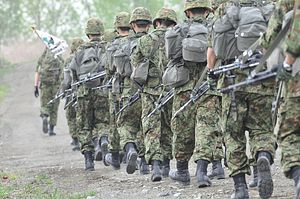Admiral Harry B. Harris, commander of U.S. Pacific Command, gave a speech on the “Role of Land Forces in Ensuring Access to Shared Domains” in the Land Forces Pacific (LANPAC) Symposium & Exposition in Hawaii on May 25, 2016. This event was hosted by the Association of the United States Army (AUSA) and a lot of general officers participated, not only from the U.S. Army but also from armies in the Indo-Asia-Pacific region. In this land force-centric event, Admiral Harris urged the Army to operate offensively out of land domains.
He stressed that the anti-ship missiles and land attack missiles of “countries like China, Iran, and Russia are challenging the ability of the United States to project power ashore, from the sea.” He pointed out that the Army should deal with these new threats beyond their traditional land-based realm. And he said, “One thing I can tell you: the question of the role of land forces in ensuring access to, and maneuver in, shared domains is something the U.S. and our friends, partners, and allies must address… not only as a matter of security, but also a matter of economic prosperity. As I just told you, our adversaries get this.”
Admiral Harris also said that “the Army’s got to be able to sink ships, neutralize satellites, shoot down missiles, and deny the enemy the ability to command and control.” However, his speech focused on the role of land forces to deny the enemy in maritime domain: “We need systems that enables the Army to project power over water, from shore.” According to Admiral Harris, “The Army should look at ways to use the Paladin and HIMARS systems to keep at risk the enemy’s Navy…not only the enemy’s land.” He apparently hoped the Army to “be back in the coastal defense game, in a completely new way.”
However, to be back in the coastal defense game in the Indo-Asia-Pacific region is not easy job for the U.S. Army. First of all, it will require much time and cost to establish coastal defense capability in the Army. Moreover, it is difficult to deploy coastal defense systems, including Paladin and HIMARS, quickly into this region across the Pacific Ocean in case of emergency. Considering these challenges, the Army’s coastal defense game in this region will need effective collaboration with regional armies.
The Japan Ground Self-Defense Force (JGSDF) has the most sophisticated coastal defense capability among the regional armies but for China’s People’s Liberation Army. JGSDF’s track-mounted surface-to-ship missile (SSM) has a range of over 150 km. Its target was originally Soviet Naval ships but at present China’s aggressive activities around Japan required a shift in focus. The JGSDF now has a plan to deploy some SSM batteries in Japan’s southern archipelago, the Ryukyu Islands, located between the East China Sea and the Pacific Ocean. Once deployed, the SSMs can establish a no-go zone for hostile ships along the Ryukyu Islands. This means the JGSDF can take charge of the coastal defense in the East China Sea front and share the area of responsibility (AOR) for region-wide coastal defense with the U.S. Army.
At the same time, the U.S. Army can share experience of the JGSDF on modern coastal defense. The first challenge for the JGSDF is the joint fire control of SSM for targets over the horizon and trying to cooperate with naval and air assets. Based on the information gathered by those assets, the joint coordinator on anti-surface operation allocates targets to Ground, Maritime, and Air Self-Defense Forces. These joint efforts are critical to make SSM effective as a cross-domain shooter. The JGSDF is also facing some challenges. Building a robust and flexible joint C4ISR network for anti-surface operations along the 1,000 km-long Ryukyu Islands chain is tough job. Sustainable logistics for SSM batteries located on remote islands is also complex challenge. In addition, if SSMs are expected to emplace minefields as Admiral Harris mentioned, another challenges will be posed: the R&D of a missile with a new warhead (sea mines) and new guidance system.
On the other hand, there are other critical ocean fronts in the Indo-Asia-Pacific region. The South China Sea is suffering the lack of effective coastal defense posture by regional armies. Therefore, the U.S. Army has to prepare for deploying coastal defense units in allies and partners around this troubled water. In addition, supporting armies in these countries to build coastal defense capability is another course of action for the Army. In that case, the JGSDF can support the Army’s capacity building efforts with its experience on anti-surface operation. The third critical ocean front is the Northern Indian Ocean. This front has the potential for military conflicts and the coastal defense will be needed to secure choke points in sea lanes of communication.
Armies in the Indo-Asia-Pacific region have to deal with wide range of missions such as ground border defense, air/missile defense, anti-terrorism, internal security, humanitarian assistance, disaster relief, and coastal defense. At the same time, every army, including the U.S. Army, struggles to get along with limited resources. Therefore, no one army alone can take charge of coastal defense in this vast region. The role of the U.S. Army is to establish a region-wide coastal defense network through the close cooperation between JGSDF and other regional armies.
Admiral Harris, you might get answers to your questions through discussions in the LANPAC but it is certain that JGSDF has answers, sir.
Nozomu Yoshitomi is a Major General, Japan Ground Self-Defense Force (Ret.) and a Professor, College of Risk Management, Nihon University in Tokyo. He has served as a field artillery officer, intelligence analyst, and researcher in JGSDF. His present research covers Japan’s defense strategy, JGSDF’s defense posture, and civil-military collaboration.

































